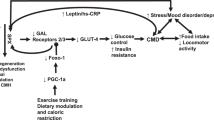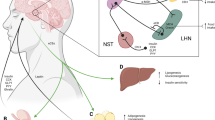Abstract
High serum levels of total and LDL cholesterol are important risk factors in the development of atherosclerotic coronary artery disease. Cholesterol metabolism is affected by nutritional, environmental and genetic factors. Neuropeptide Y (NPY), which is widely expressed in both the central and peripheral nervous systems 1, 2 , has an important role in the hypothalamic regulation of energy balance by stimulating food intake 3, 4, 5 and favoring energy storage through increased lipoprotein lipase activity in white adipose tissue 6, 7 . As a part of ongoing study of the genetic basis of obesity, we screened the NPY gene for sequence variants. We report here the identification of a common Leu(7)-to-Pro(7) polymorphism in the signal peptide of NPY. Presence of this Pro(7) in NPY was associated with higher serum levels of total and LDL cholesterol in obese subjects participating in two independent Finnish and Dutch studies. Furthermore, normal-weight Finns with Pro(7) also had higher serum levels of total and LDL cholesterol than did subjects with Leu(7)/Leu(7), as analyzed in three subsequent determinations at 5-year intervals during a 10-year follow-up period. The NPY polymorphism was not associated with higher cholesterol levels in normal-weight Dutch. Our study provides evidence that NPY is linked to cholesterol metabolism and that the polymorphism producing Pro(7) in NPY is one of the strongest genetic factors identified thus far affecting serum cholesterol, particularly in obese subjects.
This is a preview of subscription content, access via your institution
Access options
Subscribe to this journal
Receive 12 print issues and online access
$209.00 per year
only $17.42 per issue
Buy this article
- Purchase on Springer Link
- Instant access to full article PDF
Prices may be subject to local taxes which are calculated during checkout


Similar content being viewed by others
References
Gray, T.S. & Morley, J.E. Neuropeptide Y: anatomical distribution and possible function in mammalian nervous system. Nature 38, 389–401 (1986).
Lundberg, J.M. et al. Neuropeptide Y (NPY)-like immunoreactivity in peripheral noradrenergic neurons and effects of NPY on sympathetic function. Acta Physiol. Scand. 116, 477–480 (1982).
Clark, J.T., Kalra, P.S. & Kalra, S.P. Neuropeptide Y stimulates feeding but inhibits sexual behavior in rats. Endocrinology 117, 2435–2442 (1985).
Levine, A.S. & Morley, J.E. Neuropeptide Y: a potent inducer of consummatory behavior in rats. Peptides 5,1025–1029 (1985).
Stanley, B.G. & Leibowitz, S.F. Neuropeptide Y injected in the paraventricular hpothalamus: a powerful stimulant of feeding behavior. Proc. Natl. Acad. Sci. USA 82, 3940– 3943 (1985).
Billington, C.J., Briggs, J.E., Grace, M. & Levine, A.S. Effects of intracerebroventricular injection of neuropeptide Y on energy metabolism. Am. J. Physiol. 260, R321–R327 (1991).
Billington, C.J., Briggs, J.E., Harker, S., Grace, M. & Levine, A.S. Neuropeptide Y in hypothalamic paraventricular nucleus: a center coordinating energy metabolism. Am. J. Physiol. 266, R1765–R1770 (1994).
Uusitupa, M.I. et al. Apolipoprotein E phenotype modifies metabolic and hemodynamic abnormalities related to central obesity in women. Am. J. Clin. Nutr. 64, 131–136 (1996).
Ehnholm, C., Lukka, M., Kuusi, T., Nikkilä, E. & Utermann G. Apolipoprotein E polymorphism in the Finnish population: gene frequencies and relation to lipoprotein concentrations. J. Lipid. Res. 27, 227–235 (1986).
Chan L. Apolipoprotein B, the major protein component of triglyceride rich and low density lipoprotein. J. Biol. Chem. 267, 25621– 25624 (1992).
Nystrom, F., Nilsson, P., Olsson, A.G., Karlberg, B.E. & Ohman, K.P. A population study of plasma neuropeptide Y: correlations with components of the metabolic syndrome. Blood Press. 5, 349–353 (1996).
Lundberg, J.M., Franco-Cereceda, A., Hemsen, A., Lacroix, J.S. & Pernow, J. Pharmacology of noradrenaline and neuropeptide tyrosine (NPY)-mediated sympathetic cotransmission. Fundam. Clin. Pharmacol. 4, 373–391 (1990).
Sipiläinen, R., Uusitupa, M., Heikkinen, S., Rissanen, A. & Laakso, M. Polymorphism of the β3 -adrenergic receptor gene affects basal metabolic rate in obese Finns. Diabetes 46, 77–80 (1997).
Uusitupa, M., Siitonen, O., Aro, A. & Pyörälä K. Prevalence of coronary heart disease, left ventricular failure and hypertension in middle-aged, newly diagnosed type 2 (non-insulin-dependent) diabetic subjects. Diabetologia 28, 22–27 (1985).
Uusitupa, M., Niskanen, L., Siitonen, O., Voutilainen, E. & Pyörälä K. Ten-year cardiovascular mortality in relation to risk factors and abnormalities in lipoprotein composition in type 2 (non-insulin-dependent) diabetic and non-diabetic subjects. Diabetologia 36, 1175–1184 (1993).
Mooy, J.M. et al. Prevalence and determinants of glucose intolerance in a Dutch Caucasian population. The Hoorn Study. Diabetes Care 18, 1270 1273 (1995).
Acknowledgements
We thank H. Helenius (Department of Biostatistics, University of Turku) for his help and comments concerning the statistical analyses. The study was partly supported by a grant to M.I.J.U. from the Council for Health Research, Academy of Finland.
Author information
Authors and Affiliations
Corresponding author
Rights and permissions
About this article
Cite this article
Karvonen, M., Pesonen, U., Koulu, M. et al. Association of a leucine(7)-to-proline(7) polymorphism in the signal peptide of neuropeptide Y with high serum cholesterol and LDL cholesterol levels. Nat Med 4, 1434–1437 (1998). https://doi.org/10.1038/4027
Received:
Accepted:
Issue Date:
DOI: https://doi.org/10.1038/4027
This article is cited by
-
Comparison of the dipeptidyl peptidase-4 gene methylation levels between severely obese subjects with and without the metabolic syndrome
Diabetology & Metabolic Syndrome (2013)
-
Are centenarians genetically predisposed to lower disease risk?
AGE (2012)
-
Of Mice and Men: Neuropeptide Y and Its Receptors Are Associated with Atherosclerotic Lesion Burden and Vulnerability
Journal of Cardiovascular Translational Research (2011)
-
Neuropeptide Y gene polymorphisms are not associated with obesity in a South Indian population
European Journal of Clinical Nutrition (2010)
-
Neuropeptide Y gene functional polymorphism influences susceptibility to hypertension in Indian population
Journal of Human Hypertension (2010)



